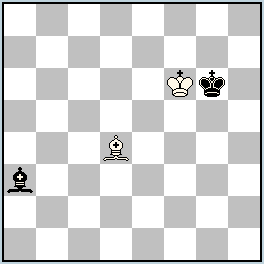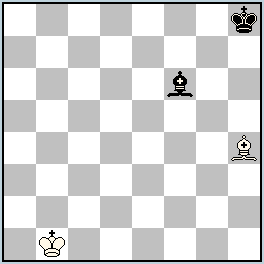| No.254 János Mikitovics (Hungary) No.254.1 János Mikitovics (Hungary) & Nikola Predrag (Croatia) |
Original Problems, Julia’s Fairies – 2013 (I): January – April →Previous ; →Next ; →List 2013(I) Please send your original fairy problems to: julia@juliasfairies.com |
No.254 by János Mikitovics – A nice echo-mate finals! (JV)
No.254.1 by János Mikitovics & Nikola Predrag – An improvement to problem No.254 based on the comments below. (JV)
Definitions:
KoBul Kings: When a piece (not a pawn) of his own side is captured, a King transforms into a Royal piece of the same type as the captured one. When the King is in the form of any Royal piece and there is a capture of one of the pawns of his own side, he becomes a normal King again. Сaptures are illegal if their result is self-cheсk because of the transformation of the Кings according to KoBul rules. Castling is allowed only if the KoBul King is on his initial square in the form of a normal King and if he has not already moved; however he may already have been transformed. In the case of capture by a King in AntiCirce he is reborn on his initial square and may castle. If the capture is by a King which is in the form of some Royal piece, he is reborn on the initial square of that piece.
KoKo: A move is possible only if the piece moved arrives on a square next to another unit.
Circe: Captured units (not Ks) reappear on their game-array squares, of the same colour in the case of pieces, on the file of capture in the case of pawns, and on the promotion square of the file of capture in the case of fairy pieces. If the rebirth square is occupied the capture is normal.
|
No.254 János Mikitovics
Hungary
original-17.02.2013
 hs#3,5 b) Kg6→d3 (2+2)
KoBul Kings KoKo Circe Solution: (click to show/hide)
|
No.254.1 János Mikitovics & Nikola Predrag
Hungary / Croatia
Version of No.254, 18.02.2013
 hs#4,5 2 solutions (2+2)
KoBul Kings KoKo Circe Solution: (click to show/hide)
|



Hm, where is the moment when a composer will decide that his problem is ready for publishing? What abot the repeated wBd4-b2, bBa3xb2(+wBc1)? Repetition of wrBxb2 at least once annihilates bB. Just one example for consideration:
Hs#3.5, 2 sol.; KoBul Kings KoeKo Circe; W:Ba3 Kb1/B: Bg7 Kg6
Congratulations, Nikola!
Your version is impeccable! This may be our joint problem if you agree with me. Hope yes!
Janos
PS: W:Ba3 Kb1/B: Bg7 Kg61
Hs#3.5, 2 sol.; KoBul Kings KoeKo Circe
I) 1…rKg6-h6 2.Ba3-c1 + Bg7-b2 3.rKb1*b2 [+bBf8] [brK=rB] rBh6*c1 [wrK=rB] + 4.rBb2-g7 rBc1-h6 #
II) 1…rKg6-f7 2.Ba3-b2 rKf7-f8 3.rKb1-a1 Bg7*b2 [+wBc1] [wrK=rB] 4.rBa1*b2 [brK=rB] rBf8-a3 #
Nikola,
Here is a version with hs#4.
JM & NP!?
White Ka4 Ba3
Black Bg7 Kg6
b) bKg6→c2
hs#4
KoBul Kings KoeKo Circe
a) 1.rKa4-b3 rKg6-f7 2.Ba3-b2 rKf7-f8 3.rKb3-a3 Bg7*b2 [+wBc1] [wrK=rB] 4.rBa3*b2 [brK=rB] rBf8-a3 #
b) 1.Ba3-c1 Bg7-b2 2.rKa4-a3 rKc2-d2 3.rKa3*b2 [+bBf8] [brK=rB] rBd2*c1 [wrK=rB] + 4.rBb2-g7 rBc1-h6 #
My proposal is unchanged.
Janos
Dear Janos, my contribution was nothing very creative, only a bit of patience. You don’t have to include me as the “serious” coauthor only because of my suggestions, I am sure that you could have done it yourself. If you see it as the result of friendly communication, I will gladly agree of course.
I don’t see the advantage of your extended proposal and the twinning spoils the impression. Consider this possibility:
Hs#4.5, 2 sol.; KoBul Kings KoeKo Circe; W:Bh4 Kb1/B:Kh8 Bf6
1…Bg7 2.Bf6 rKg8 3.Bb2 rKf8 4.rKa1 Bxb2[+wBc1][wrK=rB] 5.rBxb2[brK=rB] rBa3#
1…rKg7 2.Bg5 rKh6 3.Bc1 Bb2 4.rKxb2[+bBf8][brK=rB] rBxc1[wrK=rB]+ 5.rBg7 rBh6#
Dear Nikola, I’m very glad because came into existence our first joint fairy problem! I think, the last position with hs#4,5/2 sol. may be the final setting. If you agree with me, the co-problem can be published by Julia.
Hm, I wrote the answer more than hour ago, but probably I did not click on “Post comment”, I’m sorry.
I agree, thank you!
OK, thanks!
I have sent our joint problem also in email to Julia.
It’s nice to see the first combination of KoBul Kings with KoKo. By The Way – as I wrote before, when the King is in its Kings phase it is not necessary to be used “r” (which means “royal”). For example in a) the corect solution should be: 1…Kg6-f7 2.Kf6-g7 Kf7-f8… [instead of 1…rKg6-f7 2.rKf6-g7 rKf7-f8…] and also 4.rBg7xb2(bK=rB) instead of 4.rBg7xb2(brK=rB)
Dear Diyan,
“It’s nice to see the first combination(!) of KoBul Kings with KoKo.” This is a very big surprise for me!! Or is it just on my way the first combination? I should note, the KoBul Kings is an excellent fairy condition!
Please check the slolutions of this position:
W:Bh4 Kb1/B:Kh8 Bf6
hs# 4,5
2 solutions
KoBul Kings KoKo Circe
(The Popeye uses the rbK/wrK instead of bK/wK even if when the King is in its Kings phase.)
I) 1…Bf6-g7 2.Bh4-f6 Kh8-g8 3.Bf6-b2 Kg8-f8 4. Kb1-a1 Bg7*b2 [+wBc1] [wK=rB] 5.rBa1*b2 [bK=rB] rBf8-a3 #
II) 1…Kh8-g7 2.Bh4-g5 Kg7-h6 3.Bg5-c1 Bf6-b2 4.Kb1*b2 [+bBf8] [bK=rB] rBh6*c1 [wK=rB] + 5.rBb2-g7 rBc1-h6 #
Is this so the correct way with the Kings?
Thanks in advance for your answer!
Best wishes,
Janos
Yes, I know that Popeye uses “rK” instead of just “K”. I remember when Stephen Emmerson programing KoBul Kings in Popeye he wrote me that it will be difficult to avoid it.
But as we know, the main goal of chess solving programs is to check how correct are the chess problems and the way how they present the solution is not so important.
Will be interesting if this problem is sound as duplex (I don’t have the kobul condition to verify this).
Duplex adds unique echo! line (White starts):
1…Bh4-g5 2.Bg7 Bh6 3.Bb2 Kc1 4.Bg7 Bxg7[+bBf8][brK=rB] 5.rBh8xg7[wrK=rB] rBc1-h6#
Popeye 4.59 solves KobulKings.
Your new version (Mikitovics & Nicola) is excellent! I like it a lot!
Many thanks for the informations and your kind words!!